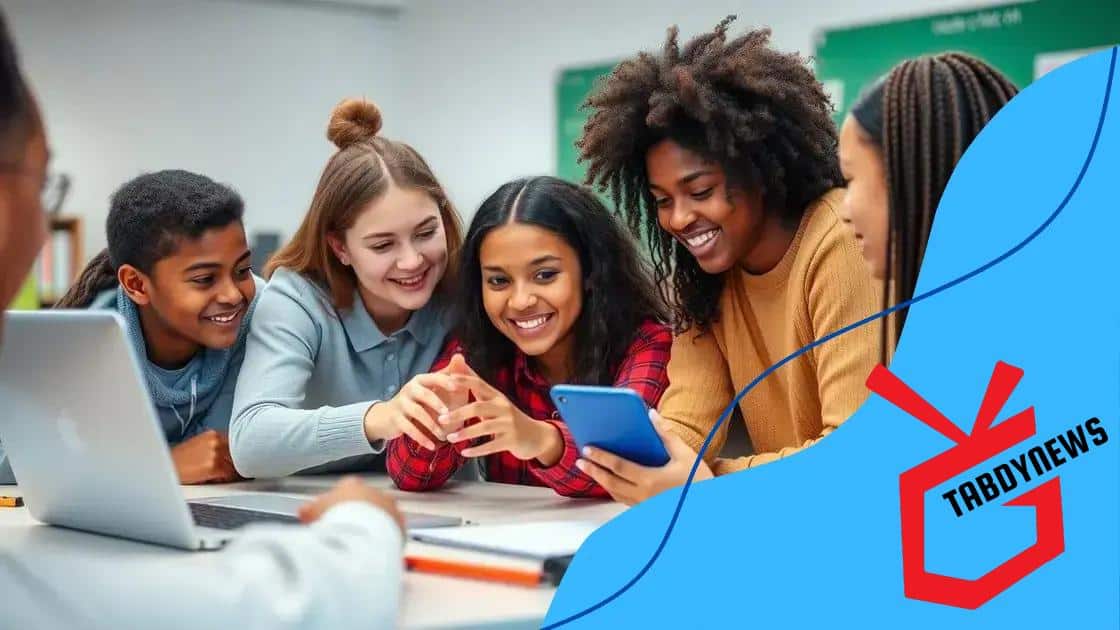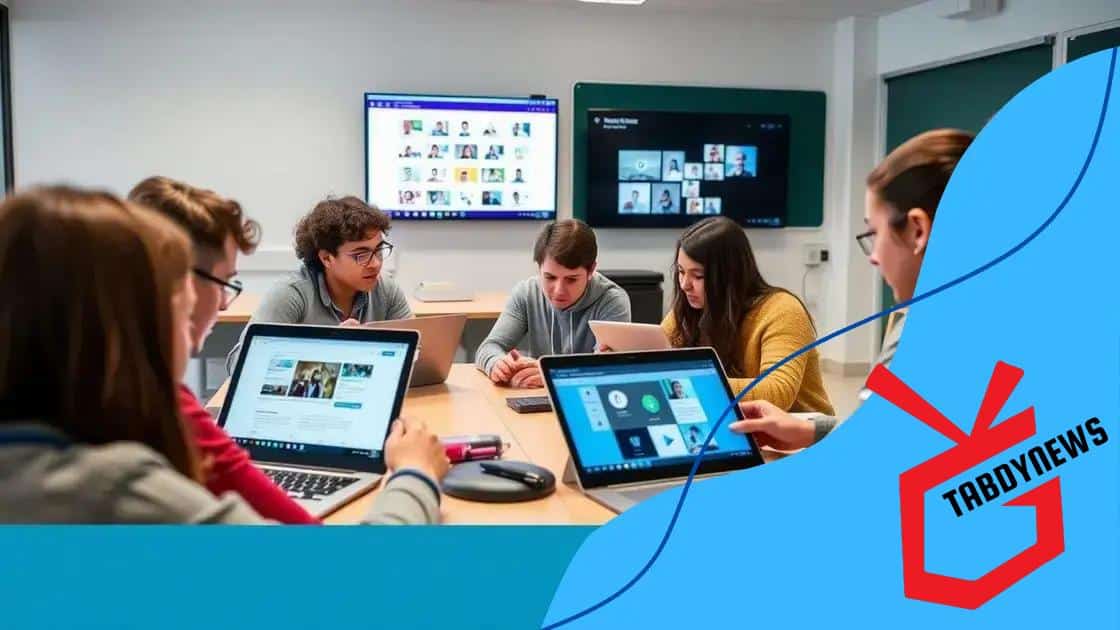Collaborative learning in digital classrooms: key benefits

Collaborative learning in digital classrooms enhances student engagement and communication skills while leveraging technology to overcome challenges such as access and participation, ultimately preparing students for future teamwork.
Collaborative learning in digital classrooms is reshaping how students interact and engage with each other. Have you ever wondered how this approach fosters creativity and teamwork? Let’s explore its potential benefits.
The essence of collaborative learning in digital classrooms
The essence of collaborative learning in digital classrooms lies in the ability to connect and engage students through technology. This method transforms traditional learning environments into vibrant communities of interaction.
When students work together, they develop skills that are invaluable in today’s world. They learn to communicate effectively, solve problems as a team, and support each other’s growth. These skills are essential for not just academic success but also for future careers.
Key Features of Collaborative Learning
Many elements contribute to the effectiveness of collaborative learning:
- Communication: Students express their ideas and listen to others, fostering a safe environment for sharing.
- Social Interaction: Working in groups encourages social skills while building friendships.
- Diverse Perspectives: Each student brings unique viewpoints that enhance understanding and creativity.
Using technology effectively is crucial in creating a collaborative classroom. Learning management systems and digital tools can provide platforms for discussion and teamwork. For example, tools like Google Classroom allow for easy sharing of materials and communication among peers. This kind of digital interaction cultivates enthusiasm and increases participation.
Moreover, collaborative learning creates a sense of community. Students take ownership of their learning, as they not only learn from the teacher but from each other as well. This dynamic can lead to greater retention of information and a deeper understanding of the subject matter.
Involving students in collaborative projects also prepares them for real-world scenarios where teamwork is essential. They learn to navigate challenges together and become more resilient in the face of difficulties.
Implementing Collaborative Learning Strategies
To successfully implement collaborative learning, educators should consider the following strategies:
- Clear Objectives: Define clear goals for group activity to guide students in their tasks.
- Group Diversity: Create diverse groups that enhance learning through varied experiences.
- Regular Feedback: Offer constructive feedback to help groups improve their collaboration skills.
In summary, the essence of collaborative learning in digital classrooms promotes a deeper understanding of materials and fosters social skills that align with future career demands. As educators and students navigate this digital landscape together, the possibilities for growth and discovery are endless. Engaging in this dynamic learning process not only benefits individual students but enriches the entire classroom community.
Benefits for students and educators
The benefits of collaborative learning for students and educators are substantial. This approach not only enhances learning experiences but also promotes essential skills for future success.
For students, the advantages include improved engagement and motivation. When they work together, students feel more connected to their peers and invested in their collective goals. This sense of belonging can transform the way they view education.
Key Benefits for Students
Some key benefits of collaborative learning include:
- Enhanced Critical Thinking: Students challenge each other’s ideas, leading to deeper understanding and sharper analytical skills.
- Improved Communication Skills: Working in teams allows students to express their thoughts clearly and listen to others effectively.
- Increased Accountability: When students rely on each other, they become more responsible for their contributions, leading to better personal performance.
Educators also reap the rewards of this strategy. By facilitating collaborative learning, teachers can foster a classroom environment that encourages exploration and innovation. This approach allows them to observe student interactions and provide targeted guidance.
Benefits for Educators
For educators, the benefits are equally important:
- More Effective Teaching: Collaborative formats can provide more ways to convey information, catering to different learning styles.
- Building a Positive Classroom Culture: Encouraging collaboration creates a supportive environment where students feel safe to express their ideas.
- Opportunity for Professional Growth: Educators can learn from their students’ interactions, gaining insights into effective teaching methods.
As students engage in collaborative learning, they not only benefit academically but also develop social and interpersonal skills that are crucial for their future. This approach equips them with tools for problem-solving and adaptability in a constantly changing world.
Tools and platforms that facilitate collaboration

In today’s digital age, various tools and platforms play a crucial role in facilitating collaborative learning. These advancements make it easier for students to work together, share ideas, and complete projects, no matter where they are located.
There are several popular tools that educators and students can utilize. Each of these platforms offers unique features tailored to enhance communication and collaboration.
Popular Tools for Collaborative Learning
Some widely used tools include:
- Google Classroom: A free platform that integrates with Google Workspace, allowing teachers to create, distribute, and grade assignments efficiently.
- Microsoft Teams: A collaboration hub that combines chat, video meetings, and file sharing to create a seamless learning experience.
- Slack: Originally designed for workplace communication, this tool provides channels for group discussions, making it useful for student groups as well.
- Trello: A visual project management tool that helps teams organize tasks, set deadlines, and track progress.
Using these platforms effectively enhances the learning experience. For example, with Google Classroom, educators can quickly share resources and provide instant feedback on student work. This immediate interaction fosters a dynamic learning environment.
Moreover, tools like Microsoft Teams allow for live collaboration on documents where students can edit and discuss in real-time. This interactive approach keeps students engaged and encourages teamwork.
As educators choose the right tools, they should consider the needs of their students. Incorporating various platforms can cater to different learning styles and preferences. Furthermore, familiarizing students with these technologies prepares them for a future that increasingly relies on digital collaboration.
In summary, leveraging technology enhances collaborative learning in meaningful ways. By integrating platforms like Google Classroom and Microsoft Teams, educators can create a rich, interactive space where students thrive together.
Best practices for implementing collaborative strategies
Implementing collaborative strategies effectively can significantly enhance the learning experience in digital classrooms. To achieve successful collaboration, educators should consider several best practices that support student engagement and teamwork.
First, establishing clear objectives is crucial. When students understand the goals of their collaborative tasks, they are more likely to stay focused and motivated. This clarity allows groups to work efficiently towards their end objectives.
Encouraging Group Dynamics
Another key practice is to foster positive group dynamics. Teachers can group students strategically to balance skills and personalities. This diverse mix helps everyone contribute while promoting mutual respect and understanding. Group activities should encourage:
- Active Listening: Students practice listening to each other’s ideas, creating an atmosphere of respect and support.
- Role Assignment: Distributing roles within the group can help ensure that all members are active participants.
- Regular Check-Ins: Educators should monitor group progress and provide feedback, ensuring students stay on track.
Utilizing technology tools is also essential for effective collaboration. Online platforms can enhance communication and project management. For instance, using Trello can help groups organize tasks clearly, making it easier to manage deadlines and responsibilities.
Additionally, fostering a culture of feedback among peers enhances collaborative efforts. Encouraging students to give and receive constructive feedback promotes a growth mindset and resilience. They learn to value differing perspectives, which can lead to richer discussions and improved outcomes.
Creating an Inclusive Environment
Creating an inclusive classroom environment is vital for successful collaboration. Educators should ensure that all students feel valued and included. This can be done by:
- Promoting Equity: Allowing equal opportunities for participation encourages quieter students to share their thoughts.
- Building Trust: Establishing trust among students can reduce anxiety about sharing ideas, leading to more open communication.
- Recognizing Contributions: Acknowledging individual contributions helps reinforce positive behavior and boosts morale.
By implementing these best practices, educators can create effective collaborative learning experiences. This approach not only enhances academic achievement but also equips students with essential skills for their future endeavors.
Challenges and solutions in digital collaboration
In the realm of digital collaboration, several challenges can arise that may hinder the effectiveness of collaborative learning. Understanding these challenges is essential for educators and students alike, as it allows for the development of effective solutions.
One common challenge is the issue of technology access. Not all students have equal access to devices or reliable internet connectivity, which can create disparities in participation. This can lead to frustration and disengagement among students who feel left out.
Technology Access Issues
To address technology access issues, schools can implement strategies such as:
- Providing Devices: Schools should consider lending devices to students who lack personal access.
- Improving Connectivity: Partnering with local internet providers can help improve access for families in need.
- Creating Resource Centers: Establishing spaces where students can access technology and support can foster collaboration.
Another challenge is communication barriers. When working in virtual teams, misunderstandings may arise due to lack of non-verbal cues, leading to confusion among group members. This can hinder effective collaboration and reduce the overall quality of group work.
Enhancing Communication
To enhance communication, educators can implement the following strategies:
- Clear Guidelines: Establishing clear expectations for communication methods can minimize misunderstandings.
- Use of Video Conferencing: Encouraging the use of video calls can help convey non-verbal cues better than text alone.
- Regular Check-Ins: Scheduling frequent check-ins allows groups to address issues promptly and keep the lines of communication open.
Additionally, students may struggle with a lack of engagement in digital settings. The virtual environment can feel isolating, leading to reduced motivation among team members. This issue can affect the quality of collaboration and lead to uneven contributions from group members.
Boosting Engagement
To boost engagement, teachers can:
- Incorporate Interactive Activities: Use polls, quizzes, and discussion forums to make collaboration more dynamic.
- Encouraging Peer Feedback: Prompting students to provide feedback on each other’s contributions fosters a sense of community.
- Setting Collaborative Goals: Establishing shared goals can motivate students to stay involved and take ownership of their projects.
By identifying challenges in digital collaboration and implementing these solutions, educators can create an environment where students feel supported and empowered to work together effectively. This approach promotes a culture of teamwork, leading to successful collaborative learning experiences.
FAQ – Frequently Asked Questions about Collaborative Learning in Digital Classrooms
What are the benefits of collaborative learning for students?
Collaborative learning enhances teamwork, communication skills, and allows students to learn from each other, which can improve overall understanding.
What challenges do educators face in digital collaboration?
Common challenges include technology access issues, communication barriers, and lack of engagement among students in virtual settings.
How can technology improve collaborative learning?
Technology provides tools for communication, project management, and resources that facilitate teamwork, making collaboration more effective.
What strategies can enhance student participation in digital collaboration?
Setting clear objectives, encouraging peer feedback, and incorporating engaging, interactive activities can significantly boost student participation.





